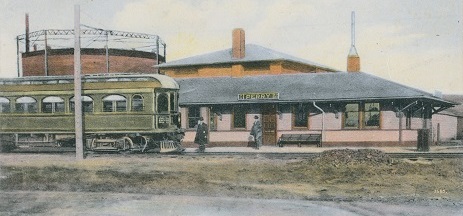
|
Mary
Matilda (Miner) Moore |
Mary Matilda (Miner) Moore was born on Jan. 27, 1898 in Marion Township, Polk County, MO, the daughter of Daniel Lucas and Mary Elizabeth (Hodges) Minerd. She was the first child born in Missouri after the family left Illinois, and as a girl moved with the family into Iowa.
Mary attended school through the eighth grade.
On May 31, 1924, in Adell, Dallas County, IA, the 26-year-old Mary wed 30-year-old Clyde Henry Moore (March 5, 1894-1978), the son of Andrew J. and Sarah (Kenyon) Moore of Minburn, IA.
Clyde stood 6 feet, 1 inch tall and weighed 175 lbs., with grey eyes and brown hair. In young manhood, when registering for the military draft during World War I, Clyde disclosed that he was a farmer, employed by his father in Rippey, Boone County, IA.
Mary and Clyde resided in the early years in Clyde's home community of Rippey, Boone County, IA.
They are not known to have reproduced.
|
|
|
Famed triangle layout of Perry, Iowa |
By 1935, they relocated to Marshalltown, Marshall County, IA. For reasons not yet known, except perhaps destitute circumstances, the Moores took in an infant niece, Shirley Jean Miner, daughter of Frederick William and Dolly (Treadway) Miner. The baby girl was in their residence in Marshalltown in 1940.
The federal census enumeration of 1940 shows the family in Marshalltown, on West Main Street, with her earning income as a laundress, and him employed as a laborer with the Works Progress Administration. The WPA was one of the ways President Franklin Delano Roosevelt and the federal government tried to overcome unemployment during the Great Depression. It is widely considered one of the Roosevelt's largest and most ambitious undertakings of his "New Deal" to get the nation back on sound economic footing. Over the years, the WPA hired millions of out-of-work individuals to build public works projects, such as roads, bridges, retaining walls and buildings.
Circa 1942, when Clyde again registered for the draft during World War II, they were back in Rippey, with him now working for Wayne Hunt.
Little else is known, and their record has not yet been found in the 1950 census.
Mary passed away in Perry on Aug. 9, 1971.
Clyde outlived her by seven years. He succumbed to the spectre of death on Feb. 26, 1978.
Their remains sleep side-by-side for all eternity in Violet Hill Cemetery in Perry.
 |
| Old interurban trolley depot in Perry |
| Copyright © 2005, 2024 Mark A. Miner |
| Minerd.com extends its gratutide to Sharon Hodge-Spencer who graciously shared her research for this biography. |
